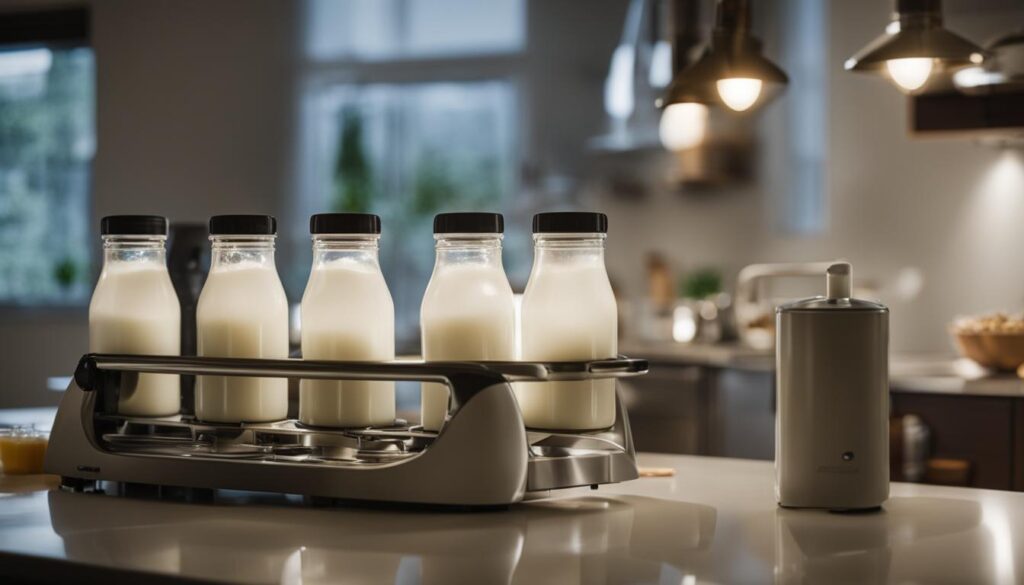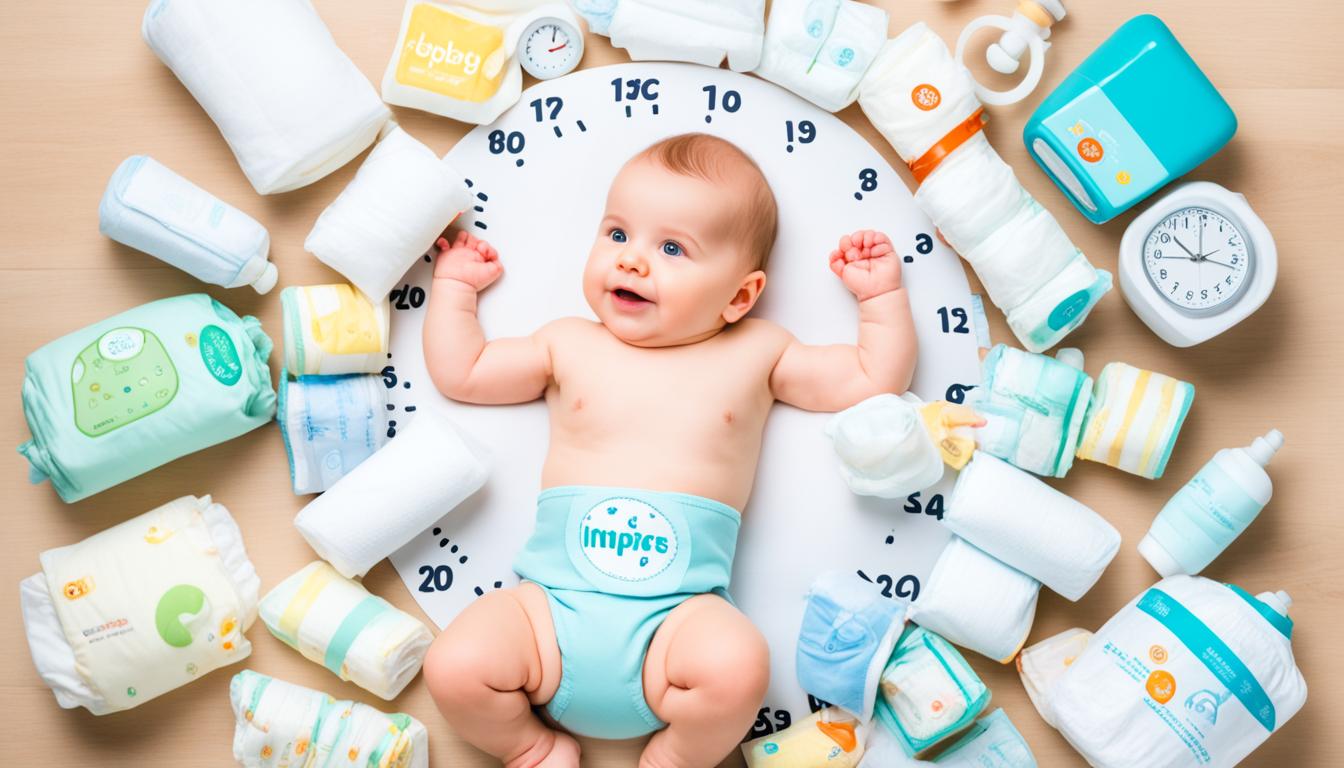Can You Leave A Bottle Warmer On All Night?
When it comes to the safety of our little ones, it’s natural for parents to have questions and concerns about everyday activities. One common question that arises is whether it’s safe to leave a bottle warmer on overnight. No, it is not recommended to leave a bottle warmer on all night.
Leaving a bottle warmer on all night can pose potential risks and safety concerns. While some bottle warmers are equipped with an auto shut-off feature, others may not have this safety measure. It is crucial to follow the manufacturer’s instructions and recommendations regarding the usage and duration of the bottle warmer.
Dangers of leaving a bottle warmer on include the risk of overheating, which could potentially pose a burn hazard to your baby or even cause a fire. Some bottle warmers have been subject to recalls due to defects that increase the risk of fire hazards. It is essential to ensure that the bottle warmer you are using is in good working order and has not been subject to any recalls. Always prioritize the safety of your baby by using caution when leaving a bottle warmer plugged in.
While convenience is important, it’s equally vital to exercise caution and take necessary precautions when using a bottle warmer. Understanding the potential risks and following safe usage practices can help ensure the well-being of your baby and provide you with peace of mind.
Skip To The Following Sections
- Different Types of Bottle Warmers and Their Safety Features
- Product Recalls and Fire Hazards
- Benefits of Preparing Bottles in Advance
- Alternative Methods for Warming Bottles at Night
- Additional Tips for Nighttime Bottle Preparation
- Considerations for Breastfeeding Mothers
- Conclusion: Prioritizing Safety and Convenience
- FAQ
- Is it safe to leave a bottle warmer on overnight?
- What are the different types of bottle warmers and their safety features?
- Are there any product recalls or fire hazards associated with bottle warmers?
- What are the benefits of preparing bottles in advance?
- What are some alternative methods for warming bottles at night?
- Are there any additional tips for nighttime bottle preparation?
- What considerations should breastfeeding mothers take into account regarding bottle warmers?
- What is the importance of prioritizing safety and convenience in bottle warming?
- Source Links
Key Takeaways:
- Leaving a bottle warmer on overnight can pose potential risks and safety concerns.
- Follow the manufacturer’s instructions and recommendations for safe usage.
- Defective bottle warmers can be a fire hazard, so ensure your bottle warmer is in good working order.
- Check for recalls to ensure the bottle warmer has not been identified as a safety risk.
- Exercise caution when leaving a bottle warmer plugged in to prioritize the safety of your baby.
Different Types of Bottle Warmers and Their Safety Features
When it comes to bottle warmers, there are various types available in the market, each offering unique features and safety considerations. Understanding the different types and their safety features can help parents make an informed decision when choosing the right bottle warmer for their needs.
Steam Heaters
One common type of bottle warmer is the steam heater. These devices use steam to heat the bottle and warm the milk or formula inside. While steam heaters are generally effective and convenient, they do come with certain risks.
- Risks of Evaporation: Steam heaters without an automatic shut-off feature can pose a risk of water evaporation from the tank. This evaporation can lead to damage, especially to the plastic components of the bottle warmer.
- Safety Considerations: When using a steam heater, it is important to choose a model that has appropriate safety features. Look for a bottle warmer with an auto shut-off feature to prevent overheating and minimize the risk of accidents.
Water Bath Warmers
Another type of bottle warmer is the water bath warmer. These warmers use a water bath to heat the bottle and ensure gentle and even warming.
- Auto Shut-Off: Some water bath warmers also come with an auto shut-off feature to enhance safety. This feature automatically turns off the warmer after a specific amount of time, preventing overheating and reducing the risk of accidents.
- Careful Temperature Control: Water bath warmers require careful temperature control to avoid overheating the bottle. It is essential to follow the manufacturer’s instructions and guidelines for proper usage and safety.
“Choosing a bottle warmer that has proper safety features can bring peace of mind to parents, knowing that their baby’s bottles are being warmed safely and efficiently.”
Product Recalls and Fire Hazards
When it comes to the safety of bottle warmers, it is crucial to stay informed about any potential risks or hazards. In recent years, there have been instances of bottle warmer recalls due to fire hazards, posing a serious danger to both property and individuals. One notable case involved Tommee Tippee electric bottle warmers in 2016, where approximately 255,000 units were recalled.
These recalled bottle warmers exhibited issues such as overheating, melting, smoking, and even catching fire. The potential risks associated with such incidents are not limited to harm from flames but also property damage, which can result in significant financial loss. In fact, according to the Consumer Product Safety Commission (CPSC), the reported property damage from these incidents amounted to $16,000.
Given the gravity of these incidents, it is imperative to take proactive measures to ensure the safety of your household. Checking if a bottle warmer has been recalled by the manufacturer is an essential step in this process. By visiting the manufacturer’s website or contacting their customer service, you can determine whether your bottle warmer is affected and avail yourself of the remedy offered by the company.
Furthermore, in addition to being aware of product recalls, it is crucial to exercise caution when dealing with electrical appliances, including bottle warmers. This includes regular inspection of their condition, especially if they are old or have visible signs of damage. Additionally, ensuring that the electrical cord is not frayed or damaged can significantly reduce the risk of electrical fires.
Key Takeaways:
- Instances of bottle warmer recalls due to fire hazards have been reported.
- In 2016, Tommee Tippee electric bottle warmers were recalled for issues like overheating, melting, smoking, and catching fire.
- Reported property damage from these incidents reached $16,000, according to the CPSC.
- Check if a bottle warmer has been recalled and take advantage of the remedy offered by the manufacturer.
- Exercise caution with electrical appliances and ensure their good condition to prevent electrical fires.
By staying informed and taking necessary precautions, you can protect your household from potential fire hazards associated with bottle warmers.
Benefits of Preparing Bottles in Advance
Preparing bottles in advance can offer convenience, especially during nighttime feedings. As a parent, I understand the importance of having everything ready when my little one wakes up hungry in the middle of the night. Having pre-made bottles on hand saves valuable time and ensures a smooth feeding process.
Pre-made bottles provide the convenience of having the formula already prepared, eliminating the need to measure and mix the ingredients each time. This is particularly helpful when you’re exhausted and in a hurry to soothe a crying baby. With pre-made bottles, you can quickly grab one from the fridge and feed your baby without any delay.
However, it’s crucial to remember that safety should always be a top priority. When preparing pre-made bottles, it’s essential to follow specific guidelines to ensure the formula remains safe for your baby to consume.
Following Guidelines for Formula Preparation
When preparing formula in advance, it’s important to adhere to the following guidelines:
- Start with freshly boiled water: Begin by boiling water and allowing it to cool to 70 degrees Celsius. This kills any potential bacteria that may be present and ensures the safety of your baby’s formula.
- Add the formula powder: Once the water has reached the appropriate temperature, add the formula powder according to the instructions provided by the manufacturer. Use the correct ratio of water to powder to maintain the nutritional balance recommended for your baby’s age.
- Cool the mixture: After adding the formula powder, cool the bottle to the appropriate feeding temperature by placing it in a bowl of cold water or using a bottle cooler. This ensures the formula is safe and comfortable for your baby to consume.
It’s important to note that pre-made bottles should be discarded after two hours to minimize the risk of bacterial growth. Any leftover formula in the bottle should be disposed of, as reheating it can cause bacteria to multiply rapidly, posing potential harm to your baby’s health.

By preparing bottles in advance and following the guidelines for formula preparation, you can ensure the safety and well-being of your baby. The convenience of having pre-made bottles ready when you need them can make nighttime feedings more efficient and less stressful.
Alternative Methods for Warming Bottles at Night
When it comes to nighttime feedings, finding alternative methods for warming bottles can save you time and provide convenience. Here are some effective ways to warm bottles without a bottle warmer:
- Using a Kettle: Heat water in advance using a kettle and leave it in the kettle overnight. When your baby wakes up for a feeding, simply pour the hot water into a container and place the bottle in it until it reaches the desired temperature.
- Thermos or Thermal Flask: Fill a thermos or thermal flask with hot water before going to bed. Keep it near your bedside for easy access when your baby needs to be fed. This method helps maintain the water temperature and ensures a quick and convenient warming process.
- Heating Pad: Wrap a heating pad around the bottle and set it to a low or medium temperature. This gentle heat can warm the bottle evenly. Remember to test the temperature of the milk before feeding your baby to avoid burns.
- Formula Dispenser Machine: Invest in a formula dispenser machine that automatically mixes and dispenses the formula at the right temperature. These machines can be a lifesaver during nighttime feedings, ensuring a hassle-free and precise preparation process.
By utilizing these alternative methods, you can easily warm bottles at night without relying on a traditional bottle warmer. Choose the method that works best for you and your baby’s needs, ensuring a comfortable and convenient feeding experience.
Additional Tips for Nighttime Bottle Preparation
When it comes to nighttime bottle preparation, efficiency and convenience are key. Here are some additional tips to streamline the process and ensure your baby’s bottle is ready quickly:
Mixing Cold and Hot Water
One time-saving trick is to mix cold and hot water to instantly bring the formula to the right temperature. Start by adding hot water to the bottle and then top it off with cold water. Be sure to test the temperature before feeding your baby.
Using a Crockpot
If you’re looking for a budget-friendly alternative to a bottle warmer, consider using a crockpot. Before bed, fill the crockpot with warm water and set it on a low temperature. This will keep the water warm overnight, making it quick and easy to warm up a bottle when needed.
Using a Cooler
Keeping bottles in the baby’s room can save you trips to the kitchen during nighttime feedings. Use a cooler to store the pre-filled bottles, ensuring they remain at a safe temperature. This way, you can easily access a bottle without having to leave the room.
Bottle Warmer with a Cooler
If you’re in the market for a bottle warmer, consider one that comes with a cooler compartment. These bottle warmers allow you to warm one bottle while keeping another bottle cool. It’s a convenient option for parents who prefer to have both warm and cold bottles readily available.
Implementing these tips can simplify nighttime bottle preparation, allowing you to feed your baby efficiently and with ease.
Considerations for Breastfeeding Mothers
For breastfeeding mothers, the advantages of breastfeeding often outweigh the need for bottle warmers. Breast milk is naturally at body temperature, making it convenient and readily available for feeding directly from the breast. The benefits of breastfeeding go beyond just the temperature of the milk. It provides essential nutrients and antibodies that boost the baby’s immune system, promotes bonding between the mother and baby, and may even reduce the risk of certain health conditions later in life.
Feeding on demand is a common practice among breastfeeding mothers, allowing the baby to nurse whenever they show signs of hunger. This eliminates the need for warming bottles and ensures instant access to milk. It is a responsive and nurturing approach that supports the unique needs and rhythm of the baby.
However, there may be situations where bottle warmers or alternative warming methods are necessary for breastfeeding mothers. For example, if a mother needs to use expressed breast milk or supplement with formula, a bottle warmer can be beneficial to warm the milk to a suitable temperature.
It is important to consider the specific needs and preferences of the breastfeeding mother and baby when determining the need for a bottle warmer. While breastfeeding provides numerous advantages, each breastfeeding journey is unique, and a bottle warmer can be a helpful tool in certain circumstances.
“Breastfeeding has so many benefits for both the mom and the baby. It helps establish a strong bond, provides essential nutrition, and offers immunological protection. However, there are situations when using a bottle warmer becomes necessary, such as when I need to use expressed breast milk or supplement with formula. In those instances, having a reliable bottle warmer ensures that the milk is warmed to the right temperature, maintaining the convenience and quality of feeding.” – Sarah, a breastfeeding mother
Advantages of Breastfeeding
| Advantages | Description |
|---|---|
| Nutritional benefits | Breast milk contains the ideal balance of nutrients for the baby’s growth and development. It provides essential antibodies that protect against illnesses and diseases. |
| Bonding and emotional connection | Breastfeeding fosters a strong emotional bond between the mother and baby, promoting a sense of security and comfort. |
| Convenience and cost-effectiveness | Breast milk is always available, at the right temperature, without the need for preparation or additional expenses on formula. |
| Reduced risk of health conditions | Research suggests that breastfeeding may lower the risk of conditions like childhood obesity, asthma, allergies, and certain infections. |
While breastfeeding offers exceptional benefits, it is essential to prioritize the mother’s comfort and well-being. Breastfeeding can sometimes be challenging, and lactation consultants and support groups can provide valuable guidance and support.
Ultimately, the decision to use a bottle warmer or rely solely on breastfeeding depends on the needs, circumstances, and personal choices of the breastfeeding mother and baby.
Conclusion: Prioritizing Safety and Convenience
When it comes to ensuring the safety and convenience of bottle warming for your baby, there are important considerations to keep in mind. First and foremost, following the manufacturer’s instructions and guidelines is crucial. This includes checking for any recalls or safety notices that may be applicable to your bottle warmer. By doing so, you can ensure that your chosen bottle warmer is in good working order and does not pose any unnecessary risks.
Preparing bottles in advance can offer convenience, especially during nighttime feedings when time is of the essence. However, it is essential to adhere to the recommended guidelines for formula preparation. This includes using freshly boiled water at the appropriate temperature and discarding pre-made bottles within two hours to prioritize your baby’s health and well-being.
Exploring alternative methods for warming bottles at night can also provide efficient solutions. Options such as using a kettle or a thermos filled with hot water, a heating pad, or a formula dispenser machine can offer convenience while ensuring that your baby’s bottle is warmed safely and quickly.
Ultimately, the well-being of your baby should be the top priority when it comes to using a bottle warmer and preparing bottles at night. By prioritizing safety and following best practices, you can provide your baby with a warm, safe, and convenient feeding experience while ensuring their health and well-being.
FAQ
Is it safe to leave a bottle warmer on overnight?
Leaving a bottle warmer on overnight can pose potential risks and safety concerns. It is important to follow the manufacturer’s instructions and recommendations for safe usage.
What are the different types of bottle warmers and their safety features?
There are various types of bottle warmers available, such as steam heaters and those with auto shut-off features. It is important to choose a bottle warmer with appropriate safety features and follow the instructions provided by the manufacturer.
Are there any product recalls or fire hazards associated with bottle warmers?
Yes, there have been instances of bottle warmers being recalled due to fire hazards. It is essential to check if a bottle warmer has been recalled and take advantage of the remedy offered by the company.
What are the benefits of preparing bottles in advance?
Preparing bottles in advance can offer convenience, especially during nighttime feedings. However, it is important to follow the guidelines for formula preparation and discard pre-made bottles within two hours.
What are some alternative methods for warming bottles at night?
Alternative methods for warming bottles at night include using a kettle, a thermos or thermal flask filled with hot water, a heating pad, or a formula dispenser machine.
Are there any additional tips for nighttime bottle preparation?
Yes, there are additional tips such as mixing cold and hot water, using a crockpot to warm water, using a cooler or a bottle warmer with a cooler, which can help streamline the process of nighttime bottle preparation.
What considerations should breastfeeding mothers take into account regarding bottle warmers?
Breastfeeding mothers may have minimal need for bottle warmers as breast milk is naturally at body temperature. However, there may be situations where a bottle warmer or alternative methods are needed, such as when using expressed breast milk or supplementing with formula.
What is the importance of prioritizing safety and convenience in bottle warming?
Prioritizing safety and convenience is crucial when it comes to bottle warming. Following the manufacturer’s instructions, checking for recalls, and ensuring the bottle warmer is in good working order are essential steps in ensuring the well-being of the baby.










